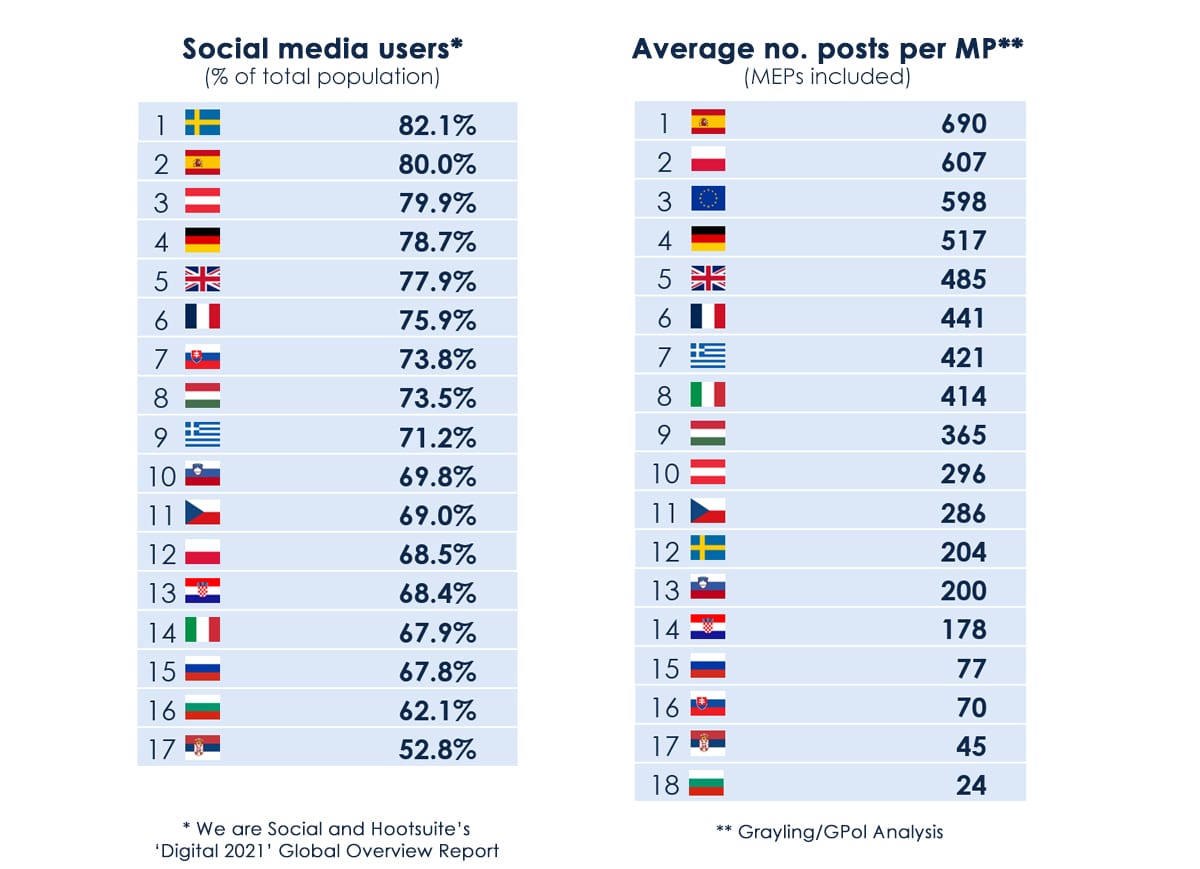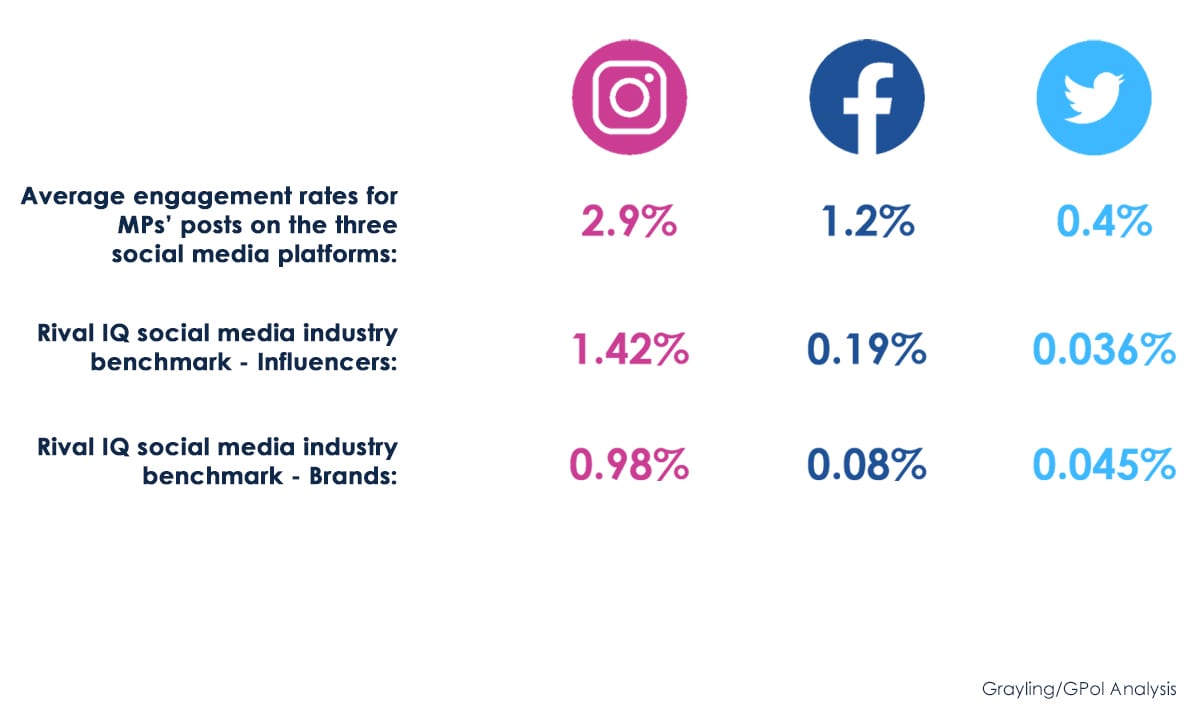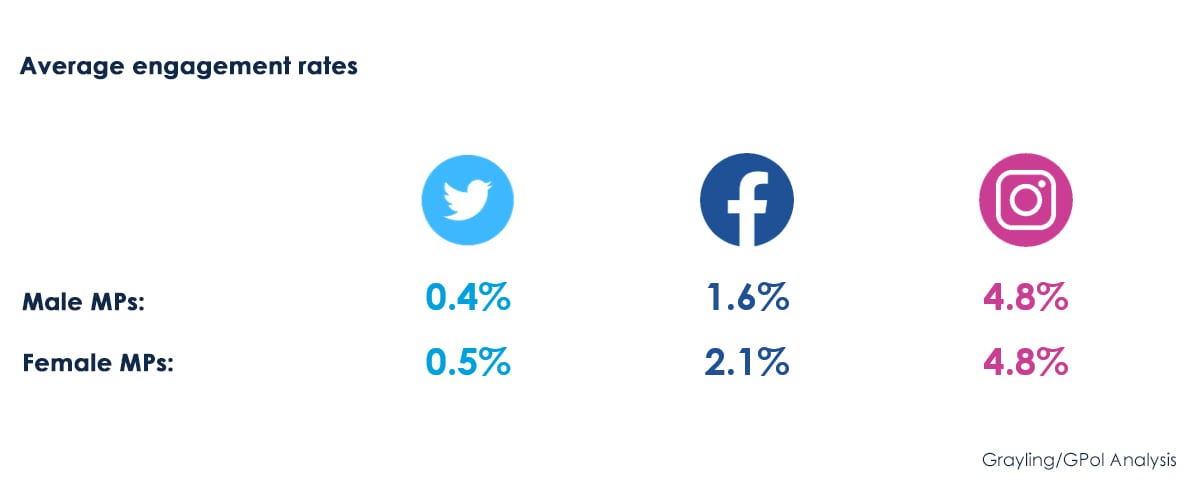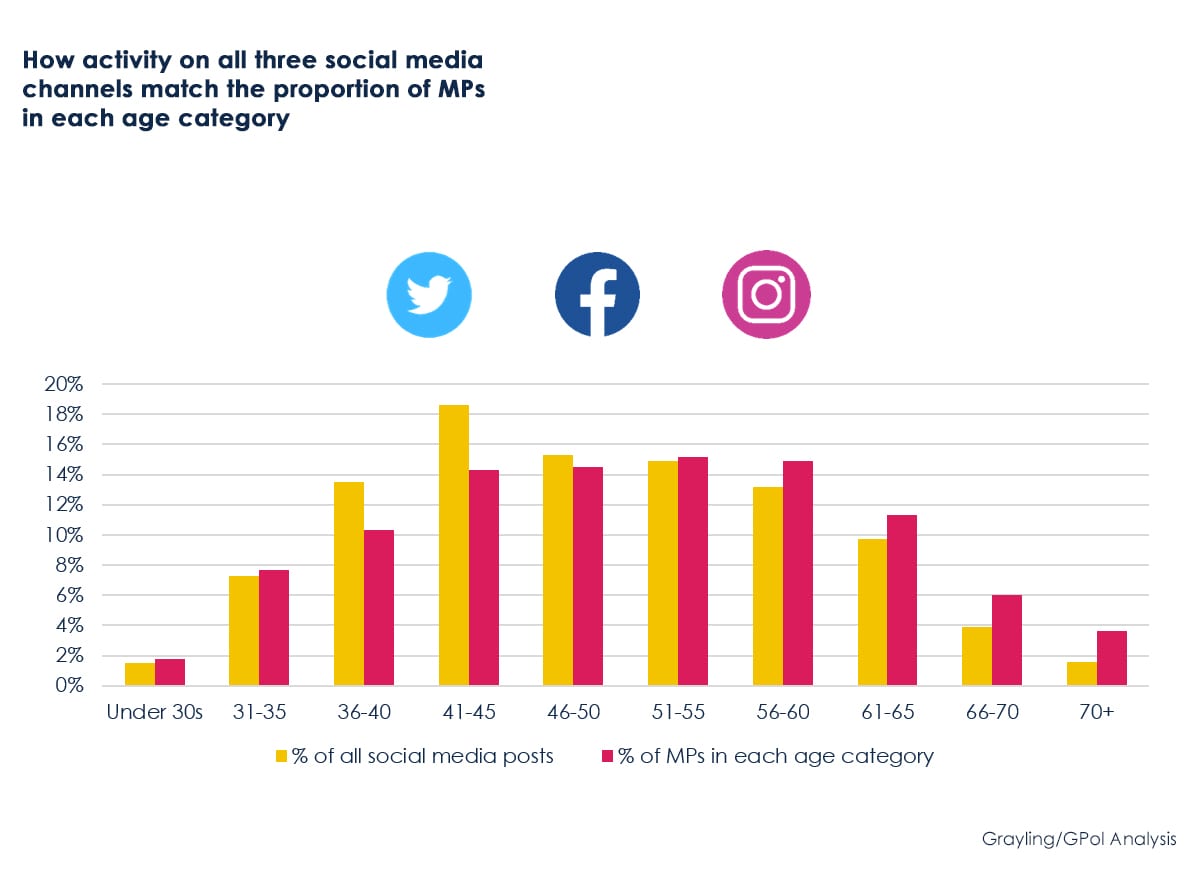Polityczni influencerzy bardziej wpływowi niż marki – pierwsze europejskie badanie Grayling
| By Ayer Mehmet | 0 Comments

Grayling zaprezentował pierwsze ogólnoeuropejskie badanie na temat sposobu, w jaki politycy korzystają z mediów społecznościowych. Analizie pod kątem płci, wieku czy przynależności partyjnej poddano prawie 3 miliony postów opublikowanych w 2020 roku na Twitterze, Facebooku i Instagramie przez parlamentarzystów z 17 krajów europejskich, w tym Polski.
“Badanie Grayling pozwala po raz pierwszy kompleksowo przeanalizować trendy wśród polityków w mediach społecznościowych i za pomocą twardych danych potwierdzić popularne tezy takie jak np. większa popularność Twittera w świecie polityki. Niektóre z wyników stanowią jednak niespodziankę i pozostawiają pole do różnych interpretacji” – mówi Iga Wilczyńska, dyrektor działu public affairs w Grayling Poland.
Kluczowe wnioski z badania
Regionalne różnice i korzystanie z mediów społecznościowych przez społeczeństwo:

1. Parlamentarzyści wybierają inne platformy społecznościowe niż ich wyborcy
Spośród trzech analizowanych platform mediów społecznościowych, Facebook jest najpopularniejszy wśród ogółu społeczeństwa w 16 z 17 krajów objętych badaniem, a Twitter jest najmniej popularny we wszystkich 17 krajach. Jednak to Twitter jest najpopularniejszą platformą wśród posłów w 13 krajach i odpowiada za ponad dwie trzecie wszystkich wpisów w 10 z nich.
2. Parlamentarzyści są „influencerami”
Na wszystkich trzech platformach średnie wskaźniki zaangażowania (tj. stosunku komentarzy/ polubień/udostępnień do całkowitej liczby osób śledzących daną osobę) są wyższe w przypadku posłów niż benchmarki branżowe dla marek, a nawet dla „influencerów” spoza świata polityki.
3. Kobiety i mężczyźni parlamentarzyści korzystają z mediów społecznościowych w inny sposób
Wbrew tendencji panującej wśród ogółu społeczeństwa, posłanki są bardziej aktywne na Twitterze i mają tam większą liczbę obserwujących niż parlamentarzyści płci męskiej. Posty posłanek generują również wyższy wskaźnik zaangażowania na Twitterze i Facebooku.
4. Najmłodsi posłowie nie stanowią najbardziej aktywnej grupy wiekowej w mediach społecznościowych
W rzeczywistości najbardziej aktywną grupą w mediach społecznościowych w całej Europie są parlamentarzyści w wieku 36-45 lat. Po 55 roku życia aktywność w kanałach online znacznie spada.
5. Politycy o skrajnych poglądach są najbardziej aktywni na wszystkich trzech platformach
W skali Europy, posty skrajnej prawicy generują szczególnie wysokie wskaźniki zaangażowania wśród odbiorców na Twitterze, podczas gdy zarówno skrajna lewica i prawica mają najniższe wskaźniki zaangażowania na Instagramie. W Polsce trend ten nie znajduje odzwierciedlenia – Lewica i Konfederacja zajmują pierwsze i drugie miejsce pod względem zaangażowania obserwujących na Instagramie.
Polscy parlamentarzyści, w większości analizowanych aspektów, wpisują się w ogólnoeuropejskie trendy. Na tle Europy wykazują się jednak większą aktywnością w mediach pod względem średniej liczby opublikowanych postów na osobę. Wynosi ona 607 i daje Polsce drugą pozycję wśród analizowanych państw, po pierwszej w rankingu Hiszpanii (690 postów na osobę). Co istotne, patrząc na ogół społeczeństwa, Polacy zajmują dopiero dwunastą pozycję w tej samej puli państw, jeśli chodzi o procent populacji, stanowiący liczbę użytkowników mediów społecznościowych (Polska – 68,5%, Hiszpania – 80%).
Polscy politycy w mediach społecznościowych – kluczowe wnioski
1. Choć Twitter wydaje się preferowanym narzędziem w komunikacji politycznej, więcej posłów posiada konto na Facebooku (444) niż na Twitterze (372). Mimo mniejszej liczby kont na Twitterze, liczba publikowanych tam treści jest jednak ponad dwukrotnie wyższa niż na Facebooku. Udział Instagrama w komunikacji polityków pozostaje natomiast marginalny. Mimo, że 257 posłów posiada konto na Instagramie, to ich posty stanowią jedynie 2,7% wszystkich treści wygenerowanych przez posłów w mediach społecznościowych (dla porównania FB: 31%, TT: 66%).
2. Posłanki są bardziej aktywne w mediach społecznościowych niż posłowie. Polskie parlamentarzystki na wszystkich platformach publikują posty częściej niż ich koledzy. Na Facebooku aż 34% udostępnianych treści jest tworzonych przez posłanki, podczas gdy ich konta na tej platformie stanowią 29% spośród wszystkich kont parlamentarzystów. W przypadku kobiet wyższy jest także wskaźnik zaangażowania obserwujących (engagement) zarówno na Twitterze (M-0,3%, K- 0,4%) jak i Facebooku (M-1,2%, K-1,8%). Jedynie na Instagramie posłowie odnotowują wyższe zaangażowanie internautów niż posłanki (M-6,4%, K-6%). Instagramowe treści posłów trafiają też do znacznie większej liczby obserwujących niż w przypadku posłanek (68% wszystkich parlamentarzystów na Instagramie to mężczyźni, ale ich wskaźnik wyświetleń sięga 85%).
Średnie wskaźniki zaangażowania w Polsce:

3. Na wszystkich trzech platformach najwyższy wskaźnik zaangażowania ze strony obserwujących występuje wobec parlamentarzystów z grupy wiekowej 31-35 lat. Dla wszystkich grup wiekowych wskaźnik zaangażowania jest wyższy na Facebooku niż na Twitterze. Najwięcej wyświetleń odnotowują natomiast posłowie w przedziale wiekowym 36-40 lat, co może oznaczać, że grupa ta wzbudza największe zainteresowanie. Skrajne grupy wiekowe (poniżej 30 lat oraz 66-70 lat) to jedyne, wśród których więcej postów zostało opublikowanych na Facebooku niż na Twitterze.
4. Parlamentarzyści Koalicji Obywatelskiej w 2020 r. wygenerowali największą liczbę postów na wszystkich platformach łącznie i odnotowali najwięcej wyświetleń przez obserwujących. Na samym Facebooku, pomimo nieco wyższej liczby postów polityków Prawa i Sprawiedliwości (37 342) niż Koalicji Obywatelskiej (33 894), posty KO wygenerowały aż o 70% więcej wyświetleń i prawie 2,5 razy więcej zaangażowania ze strony śledzących. Jeśli chodzi o wskaźnik zaangażowania, liderem jest natomiast Lewica, z najwyższym wskaźnikiem zaangażowania na Facebooku (2,5%) oraz Instagramie (8,9%). Najwyższy poziom zaangażowania na Twitterze przypadł Prawu i Sprawiedliwości (0,5%). Co ciekawe, PiS odnotowuje najniższy ze wszystkich partii wskaźnik zaangażowania na Instagramie (3,8%).
Grayling wprowadza “GPol”
Grayling, we współpracy z firmą Linkfluence, uruchomił “GPol” – usługę monitorowania mediów społecznościowych i cyfrowego advocacy. Narzędzie GPol połączy możliwości Linkfluence w zakresie social listening z wiedzą na temat lokalnych rynków i niuansów świata polityki, jaką dysponują konsultanci Public Affairs firmy Grayling w całej Europie. GPol pomoże klientom lepiej zrozumieć dyskusje toczące się w sieci, ale także przełoży te spostrzeżenia na skuteczne kampanie
z obszaru public affairs i advocacy.
W celu uzyskania dodatkowych informacji na temat badania lub usługi “GPol” prosimy o kontakt z Igą Wilczyńską: iga.wilczynska@grayling.com



 “The fact that female MPs favour Twitter even more than men is a surprise given that Twitter is the most male-dominated of the three platforms amongst the general public. There’s also, let’s face it, the abuse that politicians receive on social media, particularly on Twitter – and which afflicts female MPs even more seriously than it does men. It is partly explained by the fact that female MPs are, on average, younger (our analysis shows that younger MPs favour Twitter and Instagram) and are also more likely to be on the Left (particularly the Centre Left, where Twitter is clearly the favoured platform). And why are female MPs seeing higher engagement rates for their posts on both Twitter and Facebook? Based on a couple of micro analyses, posts which generate the strongest engagement are those which find the right tone for the moment, are constructive and avoid trying to score cheap political points. Maybe this is where female politicians have an edge over some of their male counterparts?”, said Geraldine Schroeder, Managing Director, Grayling Germany.
“The fact that female MPs favour Twitter even more than men is a surprise given that Twitter is the most male-dominated of the three platforms amongst the general public. There’s also, let’s face it, the abuse that politicians receive on social media, particularly on Twitter – and which afflicts female MPs even more seriously than it does men. It is partly explained by the fact that female MPs are, on average, younger (our analysis shows that younger MPs favour Twitter and Instagram) and are also more likely to be on the Left (particularly the Centre Left, where Twitter is clearly the favoured platform). And why are female MPs seeing higher engagement rates for their posts on both Twitter and Facebook? Based on a couple of micro analyses, posts which generate the strongest engagement are those which find the right tone for the moment, are constructive and avoid trying to score cheap political points. Maybe this is where female politicians have an edge over some of their male counterparts?”, said Geraldine Schroeder, Managing Director, Grayling Germany.
